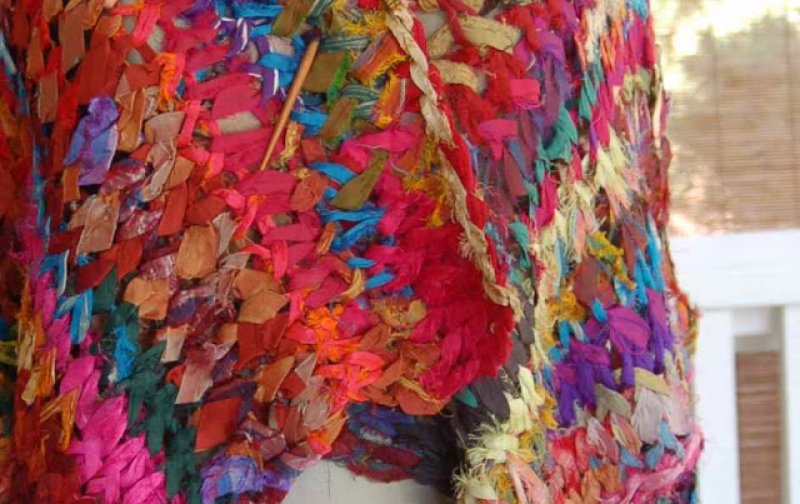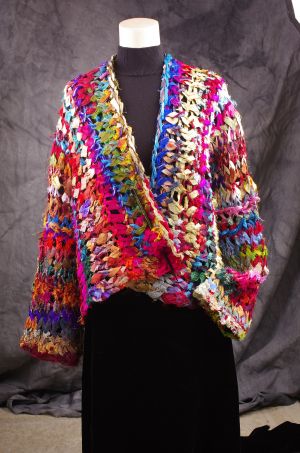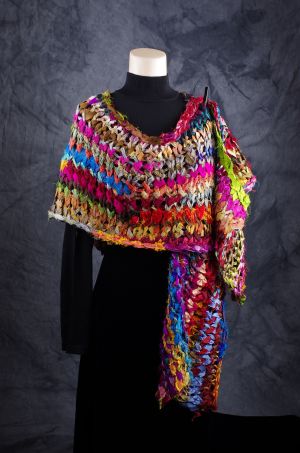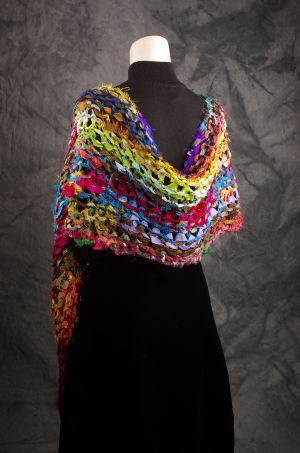
By Cheryl Oberle
For the last year I've enjoyed playing with Sari Silk Ribbon from Treenway Silks as a knitting medium. Working with the artisan-created streamers of beautiful colors and varying textures, I came to almost recognize the work of particular women by the way they picked the ribbons to sew together on their vintage sewing machines. I feel a connection to these artists in India and a real appreciation of their craft. And I've never made a garment more quickly.
Using size 35 needles and knitting at a gauge of 1 stitch per inch is a great change from my ususal knitting habits, knits me right out of the box, and with some special finishing to the fabric, it can become a drape-y, silky, amazing garment. My Peruvian Sari Silk Ribbon Jacket is one example of what you can do and in a wink!
If you are looking for a refreshing, unbelievably quick knit and want to fill your color rods with marvelous hues at the same time, give this technique a try.
Below is the skinny, as published in my patten technique notes, on how I finished the fabric to give it this marvelous drape. It is rather unconventional, but so is this yarn and both work beautifully. Hope you have some fun, too!
Sari Silk Ribbon Knitting: Notes on Finishing
Before being put together, the pieces of the garment are blocked. This is an absolutely necessary and special technique that really “creates the fabric” and gives the garment it’s shaping and drape. Do not put the jacket together before the pieces are blocked and have dried as described below.
Finishing the Fabric / Shaping the Garment
This is not traditional blocking of knits and all the information here applies only to Sari Silk Ribbon Garments. Do not block this way on regular knitting as you will completely flatten your regular knitting. This is a technique that flattens the knit stitches, shaping and changing the dense knitting into a gorgeous flowing silken mesh fabric.
Equipment needed:
-Steam iron
-Pressing cloth, at least one, that you don’t mind getting a possible dye stain on.
-Ironing board or surface that you can use high heat and steam on.
-Extra Cover for ironing board, again to prevent a possible dye stain on your regular ironing board cover. A doubled piece of muslin or an old sheet will work perfectly here. You want it smooth so you can move the garment around easily while shaping. Do not use a towel; too dense and grabby.
-Pins if you decide to pin your piece out until it dries.
Steps
1. Place the extra cover on the ironing board or ironing surface.
2. Set iron to highest heat and steam setting (Note: Do not ever touch the fabric with the iron unless the pressing cloth is in place between the iron and the silk. Scorched silk look, feels and smells terrible!).
3. Wet the pressing cloth until it is saturated but not dripping.
4. Place the garment on the covered board right side up and put the pressing cloth on top. You will steam and really press the fabric (lots of hissing going on), flattening it as you go. Use pressure.
5. Take the cloth back piece, and, being careful not to burn yourself on the hot silk, begin to stretch and smooth it out. The point is to flatten the stitches and stretch open the knitting until it looks like a lattice and the stitches lay flat and gleaming. You will continue to steam and stretch/smooth the fabric until you get it to the desired measurements.
Measure as you work and don’t be afraid to stretch the garment if necessary to get the measurements. The Sari Silk Ribbon will shrink slightly once it is damp and that is normal. Some of this will release once the fabric is dry. Also some of the sari silks may leave dye impressions on your pressing cloth or cover. Once the ribbon dries, the dyes are again stable.
Be sure to focus on the edges, pressing them nice and flat which makes a beautiful edging for your garment. Be aware the the silk will stiffen from the steam and moisture. It may feel like it’s been starched. This is perfect and will help the piece keep it’s shape until it dries. You may pin it out if you think that is necessary. Once dry. the knitted fabric becomes flexible and drape-y. Lovely!
6. It is recommend that you dry clean the garment when it becomes necessary to do so after wearing. (Find a cleaners that is environmentally friendly, please). Think of a silk tie and take care of your garment just like that.
--Cheryl Oberle
Want to try knitting with Sari Ribbons? You can find our silk Sari Ribbons here.
Cheryl's Peruvian Sari Silk Ribbon Jacket uses 600g of silk ribbon, so plan on ordering 6 skeins.
Love the look of the knitted sari ribbons, but want something simple? A shawl can be very dramatic. Cheryl is tall and elegant, so she knitted hers quite long, using 450g of sari ribbons.
If you're a bit shorter, like me, then 400g of sari ribbons should be sufficient.




